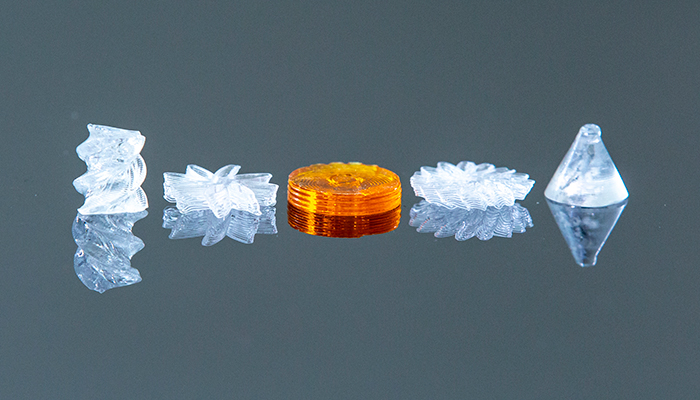LLNL Scientist Shares the Wonder and Beauty of Additively Manufactured Optics
January 12, 2023
 Objects printed using LLNL’s Tailored Glass Using Direct Ink Writing Technology, which Rebecca Dylla-Spears described in a CaliBaja Glass Science + Art Webinar Series talk. Photo by Jason Laurea.
Objects printed using LLNL’s Tailored Glass Using Direct Ink Writing Technology, which Rebecca Dylla-Spears described in a CaliBaja Glass Science + Art Webinar Series talk. Photo by Jason Laurea. There’s never been a more exciting time to be working in additively manufactured glass, said Lawrence Livermore National Laboratory (LLNL) scientist Rebecca Dylla-Spears.
The Lab chemical engineer delivered that message to attendees of a CaliBaja Glass Science + Art Webinar Series in August 2022. In her talk, titled “Taking Control: New Possibilities with Glass Additive Manufacturing,” she discussed the current state of the art, the Laboratory’s portfolio of work, and exciting future possibilities.
A scientist in the Materials Science Division, Dylla-Spears oversees a research portfolio that stems from a strategic initiative aimed at 3D-printed optics that contain functional gradients in material properties for National Ignition Facility (NIF) experiments and other applications.
“We are interested in optical materials because Lawrence Livermore is a leader in delivering leading-edge laser and optic solutions, and has been for the past 50 years,” she explained. “In fact, we just celebrated the 50th anniversary of the laser program this year.”
Dylla-Spears detailed the Laboratory’s Tailored Glass Using Direct Ink Writing technology, which is used to print silica-based optics and glass components with customizable forms and spatially varying material properties. The work received a 2022 R&D 100 Award.
She also described volumetric additive manufacturing (VAM), an emerging technique that allows parts to be printed without layers. She shared examples of a VAM demonstration from a collaboration between the University of California, Berkeley, University of Freiburg (Germany), and LLNL.
In her talk, Dylla-Spears also shared the breadth of opportunities in material science at LLNL. “Materials science at LLNL covers an astounding range of materials and capabilities, over multiple scales, and in various domains,” she said. “Our missions require understanding from the atomic scale to the component or device scale and all the way up to the system scale. Projects span from fundamental science endeavors through fielded systems. And as part of that breadth of scope, we get to collaborate with colleagues who have expertise across a range of disciplines and experiences. There are so many opportunities to learn and to contribute.”
The CaliBaja Glass Science + Art Webinar Series is a collaboration between the University of California, San Diego’s CaliBaja Center for Resilient Materials and Systems, the University of Nevada-Reno, and the Central American Foundation for the development and research of glass art (FUNCDEVI).
The webinar series is free for students, researchers, and the general public via Zoom and has offerings in both English and Spanish. This year’s series honored the International Year of Glass, with each Iberoamerican Year of Glass Summer 2022 session including a glass scientist and a glass artist.
View the entire talk here.
—Patricia Koning
Follow us on Twitter: @lasers_llnl



